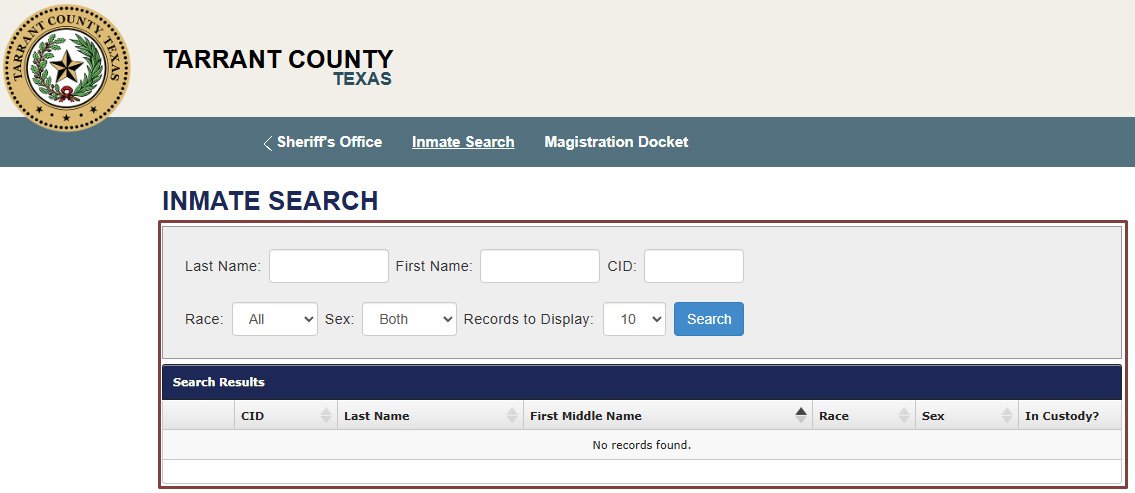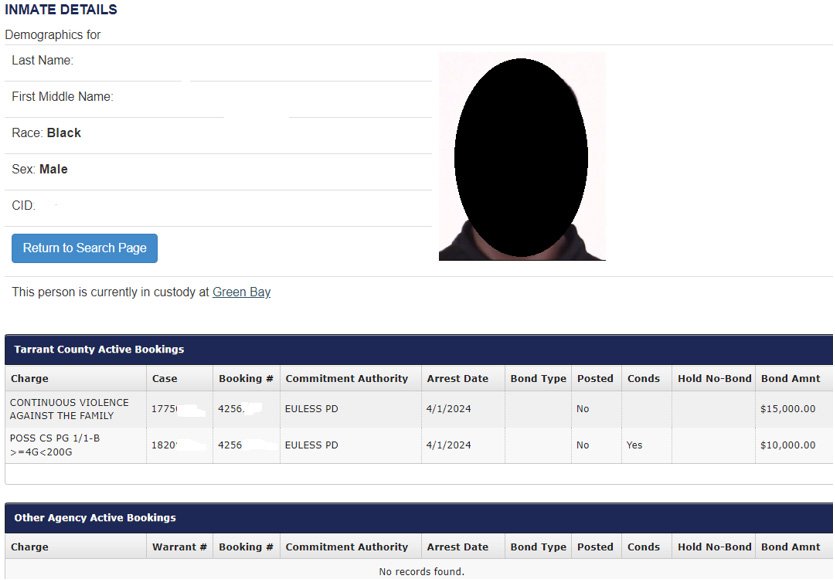With a population of 2,110,640, Tarrant County became the third most populous county in Texas. Established in 1849, the county seat of Tarrant County is in Fort Worth, which runs several government organizations, including the Tarrant County Sheriff’s Office.
To provide transparency to the public, the sheriff’s office provides resources that they can easily access online, such as information about the sheriff’s administration, law enforcement division, and detention bureau.
To look for information about incarcerated individuals, the public can take advantage of the inmate search tool, but some do not know how to access it. Thankfully! We’ll show you the guide below!
Guide to Accessing the Tarrant County Inmate Search Tool
To access the Tarrant County Inmate Search tool, you can visit the official website of the Tarrant County Sheriff’s Office and find “Inmate Search.” Or you can also access it here ⇒ inmatesearch.tarrantcounty.com
The tool will look like this:

You can start typing the inmate’s first or last name. If you don’t know their full name, you can only type their first or last name.
To narrow down your search, you can also enter the inmate’s race, gender, and arresting agency.
Then, click search.
Under the tool, you’ll see the list of inmates based on what you search for. Make sure to find the inmate you’re looking for.

If you find one, you can click “Details” to see more information about it.
On the details page, you’ll find the following:

Now, you can try to access the Tarrant County Inmate Search tool by following our steps above.
About Tarrant County Corrections Center
The prison industries in Tarrant County are operated under the rules and procedures established by the Texas Commission on Jail Standards. There are five correctional facilities in Tarrant County that house approximately 5,000 prisoners.
Lon Evans Correction Center is one of the correctional facilities in Tarrant County that passed certification in October 2012. The U.S. Green Building Council’s (USGBC) Leader in Energy Environment Design (LEED) has classified this facility as a gold-certified facility, the USGBC’s second-highest certification, and it is awarded for the efficient use of water, energy, and materials.
Tarrant County Correction Center employs about 1,000 certified staff who serve as detention officers or peace officers by the Texas Commission on Law Enforcement (TCOLE).
The Tarrant County Jail is located inside the Tarrant County Correction Centers, which are supervised by one officer. It also has about 18 female prison volunteers who want to learn sewing.
Read also: List of Vocational Programs in Prisons
It is recorded that approximately 35,000 inmates are admitted to the Tarrant County Detention Center each year. The inmates will be photographed and registered with their irises.
The following are the locations of Tarrant County correction facilities:
- Tarrant County Corrections Center: 100 N. Lamar St., Fort Worth, TX 76196 (817-884-3000)
- Tarrant County Lon Evans Jail: 600 W. Weatherford St., Fort Worth, TX 76196 (817-884-3000)
- Tarrant County Green Bay Jail: 2500 Urban Drive, Fort Worth, TX 76106 (817-884-3000)
- Tarrant County Jail: 1815 Cold Springs Rd., Fort Worth, TX 76196 (8178843116)
Inmate Services
Tarrant County also provides various services for inmates. All facilities at Tarrant County Correction Centers provide inmate medical services to monitor chronic disorders; dental services to treat dental complaints, trauma, and tooth extraction; vision services to examine eyes; and inmate counseling for physical and mental services.
Each day, the prison serves approximately 10,250 hot meals with menus created by registered nutritionists to meet the nutritional needs of every inmate. In addition, special menus are also prepared for inmates who have medical, dietary, or religious requirements.
In addition, there are numerous programs for inmates administered by the Inmate Services and Chaplaincy Division, including:
Religious program
This program allows inmates to improve themselves while they’re incarcerated. Inmates can make a request to invite religious faiths to the jail through the chaplain’s office, but it will be done with non-contact visits. During a visit, inmates and the minister are separated by some form of partition or barrier that can prohibit actual physical contact.
Each visit with the chaplain is limited to 30 minutes and occurs once a day. In order to make these visits, the pastor must be on the “Approved Pastors List” maintained by the Office of Pastors.
Educational program
Tarrant County Jail offers an education program to every inmate, so they can have the opportunity to improve their education while they’re in prison. General Educational Development (G.E.D.) and language skills are the primary courses provided.
Recreational program
The recreational program here aims to provide a space for inmates to gain entertainment. The Tarrant County Jail carries out the procurement of TVs and recreation equipment for all prison facilities so inmates can access them.
Law and recreational libraries
Every inmate will be granted access to law and recreational libraries to prepare their own legal documents. At the library, they’ll have newspaper and magazine subscriptions.
When it comes to the industries in the prison, the Tarrant County jail employs inmate volunteers to contribute to the production of prison goods, such as inmate clothing, inmate bedding, mattress covers, sleeping mats, etc. It actually aims to reduce prison budgets and also allow inmates to engage in activities that are beneficial for themselves.
Inmate Visitation at Tarrant County Correction Center
All facilities at Tarrant County Correction Centers use an alphabetical visiting system based on the inmates’ names. You have to register first, about 30 minutes before visiting.
- For inmates whose last name begins with the letters A through L, the visitation can be conducted on Saturdays and Mondays from 9 a.m. to 9 p.m.
- For inmates whose last name begins with the letters M through Z, the visitation can be conducted on Saturdays and Mondays from 9 a.m. to 9 p.m.
- For attorneys or law enforcement officials, the visitations can be conducted on Wednesday and Thursday from 9 a.m. to 9 p.m.
- For medical staff, the visitation can be conducted on Sunday through Saturday at 5 p.m. through 9 p.m.
Each visit is limited to one 30-minute visit per day and can only accommodate a maximum of two adults and two children. Every inmate can receive three family visits per week, not including attorneys and medical staff.
As a visitor, you actually have to follow the rules and regulations for your visit, including the dress code. When visiting an inmate, you must dress appropriately. If you wear inappropriate clothes, you’ll be rejected for a visit.
The following are inappropriate dressings you shouldn’t wear:
- Sundresses
- Halter tops
- Revealing shorts
- Leotards
- Bathing suits
- Low-cut blouses or dresses
- See-through garments of any type
- Miniskirts
- Backless tops
- Spandex or tight-fitting pants or blouses
- Hats or caps
- Sleeveless garments
- Skirts above the knee, no more than two inches
- Military-style clothing
- Clothes that represent certain institutions
- Dresses or skirts with a high slit in the middle of the back, front, or side
Identification will be conducted for every visitor. Sure, you should bring a valid identification that contains your photograph, such as:
- Your driver’s license from any state.
- A state-issued card from any state.
- A valid passport
- An immigration ID card
- A military ID card
- Mexican Consulate cards
Last, you should follow the facility’s rules regarding the items that are allowed or not allowed to be brought.
The following are items that you can bring to the facility:
- One diaper bag that can fit blankets and bottles
- A little bit of money to purchase snacks in a vending machine
The following are prohibited items to bring to the facility:
- Tobacco
- Lighters
- Matches
- Cameras
- Clectronic recording devices
- Cell phones
- Cackpacks
- Cags
- Purses
- Unlabeled prescription medication
- Food or drinks, except as allowed for infants
Inmate Money Deposit
As of January 2018, Tarrant County Correction Centers helps the inmate’s families and friends send money online through Access Corrections, so they do not need to place money in the facility’s lobby. The facility no longer receives cash in person or by mail, unless you send money with your Visa or Mastercard.
You can only send money to the inmates at Tarrant County jail in the following ways:
- Via Smart Device App: You can download the app on Android or iOS phones.
- Online: You can visit accesscorrections.com or use the Access Corrections app.
- By phone: You can call the representative at 866-345-1884.
Inmate Mailing Services
Tarrant County jail allows inmates to send and receive letters. They can purchase writing supplies such as paper, pens, envelopes, and stamps from their commissary.
If you want to send a letter to an inmate, it should be no larger than 12” by 16”. If you include contraband items, such as inappropriate photographs, on the envelope, these will be returned to your address.
You can send an inmate letter:
Inmate Full Name and CID Number
C/O Tarrant County Jail
100 N. Lamar
Fort Worth, Texas, 76196
Tarrant County jail is only responsible for mail that is delivered by the U.S. Postal Service.
AUTHOR BIO
On my daily job, I am a software engineer, programmer & computer technician. My passion is assembling PC hardware, studying Operating System and all things related to computers technology. I also love to make short films for YouTube as a producer. More at about me…



















